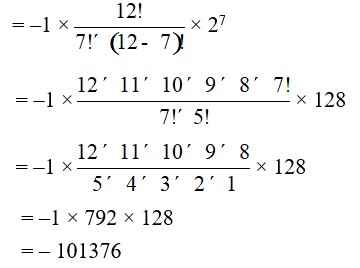Maths
Get insights from 6.5k questions on Maths, answered by students, alumni, and experts. You may also ask and answer any question you like about Maths
Follow Ask QuestionQuestions
Discussions
Active Users
Followers
New answer posted
6 months agoContributor-Level 10
5. Let (r + 1)th term be the general term of (x2–y)6.
So, Tr-1 = 6Cr (x2)6-r (-y)r
= (–1)r .6Cr . .
New answer posted
6 months agoContributor-Level 10
For a homogenous D.E. of the formula
We put,
Option (c) is correct.
New answer posted
6 months agoContributor-Level 10
The given D.E. is
i.e, the given is homogenous.
Let, so that is the D.E.
Then,
Now,
Putting back we get,
and y= 2
The particular solution is,
New answer posted
6 months agoContributor-Level 10
4. Let a5b7 occurs in (r + 1)th term of [removed]a – 2b)12.
Now, Tr+1 = 12Cra12-r (–2b)r
= (–1)r12Cra12–r . 2r. br
Comparing indices of a and b in Tr-1 with a5 and b7 we get, r = 7
So, co-efficient of a5b7 is (–1)712C7 27

New answer posted
6 months agoContributor-Level 10
The given D.E.is
i.e, the given D.E. is homogenous.
Let, So that, in the D.E
Then,
Integrating both sides we get,
Putting back we get,
Given,
The required particular solution is
New answer posted
6 months agoContributor-Level 10
The given D.E.is
i.e, the given D.E is homogenous.
Let, so that, in the D.E.
Integrating both sides we get,
Putting back we have,
Then, when,
The required particular solution is,
Taking an Exam? Selecting a College?
Get authentic answers from experts, students and alumni that you won't find anywhere else
Sign Up on ShikshaOn Shiksha, get access to
- 65k Colleges
- 1.2k Exams
- 679k Reviews
- 1800k Answers
